7 Parsley Health Benefits That Will Surprise You

Originally found in the Mediterranean but now cultivated worldwide, parsley is a versatile herb with leaves and roots that are used mainly as a garnish or condiment to spice-up foods. It’s quite low in calories but is packed with flavor, making it a great low-calorie ingredient for a variety of recipes.
It has, however, been used for centuries in traditional herbal medicine to treat a plethora of medical conditions. It’s been used to regulate menstrual flow; treat cancers, anemia and arthritis, and as a carminative to relieve flatulence. It’s also used as an aphrodisiac and a hypotensive remedy.
This fragrant herb also contains essential oils that have antibacterial properties. While some of these claims might not stand up to strict medical scrutiny, there are a number that can. Among these:
1. Parsley has antibacterial properties when used as an extract. A test-tube study demonstrated that the extract showed significant antibacterial activity against yeast, molds and an infection-causing bacterium known as Staphylococcus aureus, which can cause pneumonia and meningitis, among others.
The extract may also prevent the growth of bacteria in food. Another test-tube study found it prevented the growth of potentially harmful bacteria, such as Listeria and Salmonella — both known to cause food poisoning.
2. Parsley contains many important nutrients. This herb offers a lot more nutrients than many people think. A 1/2 cup or 30 grams of fresh, chopped parsley provides: calories (11 calories), carbs: (2 grams), protein (1 gram), fat (less than 1 gram), fiber (1 gram), vitamin A: 108 percent of the Reference Daily Intake (RDI), vitamin C: 53 percent of RDI, vitamin K: 547 percent of RDI, potassium: 4 percent of RDI and folate: 11 percent of RDI.
3. Parsley supports bone health with vitamin K. Parsley is packed with vitamin K, which is an essential nutrient in bone health. A 1/2 cup (30 grams) of parsley provides a huge 547 percent of RDI.
Vitamin K helps build stronger bones by supporting the body’s bone-building cells. It also increases bone mineral density, which is a measure of the amount of minerals present in bones. A lower bone mineral density is associated with an increased risk of fractures, especially in the elderly.
Some studies suggest eating foods high in vitamin K might reduce the risk of fractures. One study found that higher vitamin K intake was associated with a 22 percent lower risk of fractures (17, 18).
Typical dietary intakes of vitamin K may be below the levels needed to improve bone mineral density and reduce fracture risk. Therefore, eating foods like parsley may benefit bone health (19).
4. Parsley is rich in antioxidants. It contains many powerful antioxidants that prevent cellular damage from molecules called free radicals. The main antioxidants in parsley are flavonoids, carotenoids and vitamin C.
Parsley is particularly rich in flavonoids that might lower your risk of certain conditions, including colon cancer, type 2 diabetes and heart disease. Dried parsley might be higher in antioxidants than fresh sprigs. One study found the dried herb had 17 times more antioxidant content than its fresh counterpart.
5. Parsley contains cancer-fighting compounds that may have anticancer effects. It’s packed with flavonoid antioxidants and vitamin C, which reduce oxidative stress and might lower your risk of certain cancers. A high dietary intake of flavonoids may reduce colon cancer risk by up to a 30 percent.
Eating foods rich in vitamin C might reduce the risk of cancer, as well. Half a cup (30 grams) of parsley provides 53 percent of RDI for this nutrient.
6. Parsley is rich in nutrients that protect your eyes. Lutein, beta carotene and zeaxanthin are three carotenoids in parsley that help protect your eyes and promote healthy vision.
Beta carotene is another carotenoid that supports eye health. This carotenoid can be converted by your body into vitamin A. This conversion of beta carotene explains why parsley is very rich in vitamin A.
Vitamin A helps protect the cornea, the outermost layer of the eye and the conjunctiva (the thin membrane covering the front of the eye and the inside of the eyelids).
7. Parsley is easy to add to your diet. Dried parsley can be used as an ingredient in many recipes. It will enhance the flavor of soups and stews and is often combined with other herbs in Italian-inspired recipes.
Fresh parsley is a great addition to homemade salad dressings, marinades, and seafood recipes. Many people use fresh sprigs in recipes that don’t require cooking or add the herb at the end of the cooking period.
Published by Medicaldaily.com



























